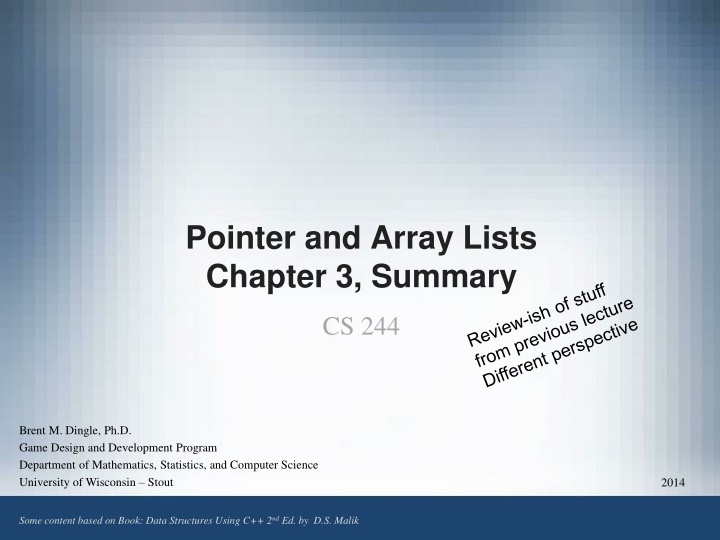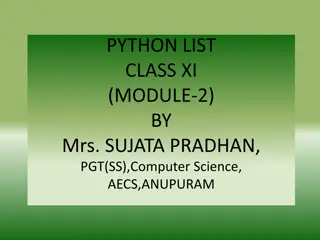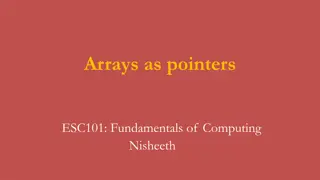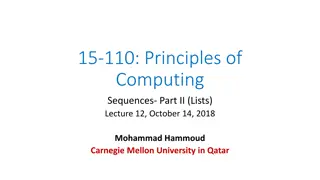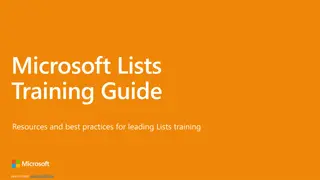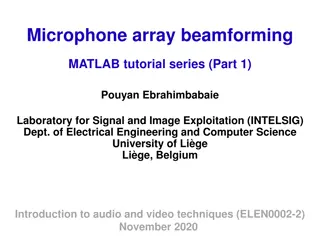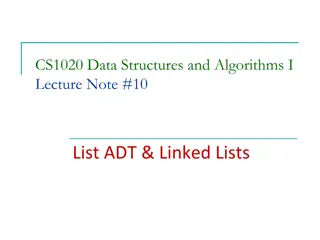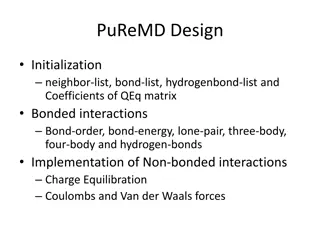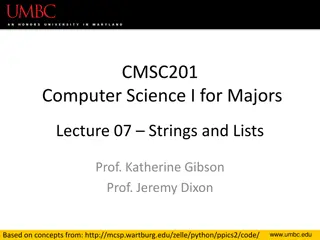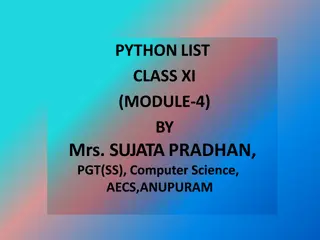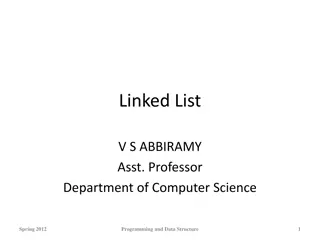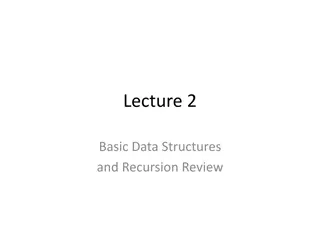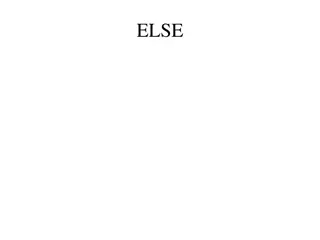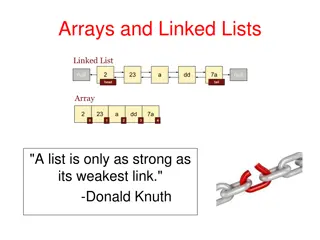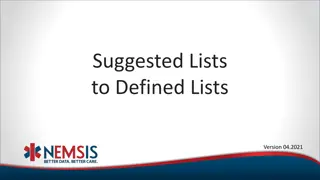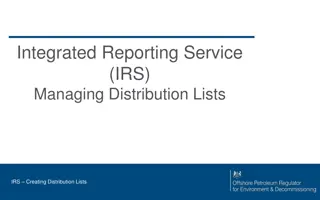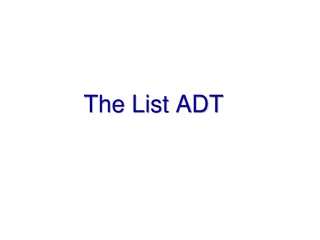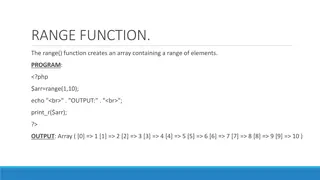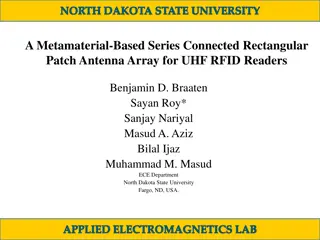Pointer and Array Lists
In chapter 3 of "Data Structures Using C++", Dr. Brent M. Dingle covers pointer data types, declaring pointer variables, address-of and dereferencing operators, dynamic variables, pointer arithmetic, dynamic arrays, shallow and deep copies, classes with pointer data members, dynamic arrays for processing lists, virtual functions, and abstract classes. Dive into the fundamentals of managing memory addresses and manipulating data using pointers in C++.
Download Presentation

Please find below an Image/Link to download the presentation.
The content on the website is provided AS IS for your information and personal use only. It may not be sold, licensed, or shared on other websites without obtaining consent from the author.If you encounter any issues during the download, it is possible that the publisher has removed the file from their server.
You are allowed to download the files provided on this website for personal or commercial use, subject to the condition that they are used lawfully. All files are the property of their respective owners.
The content on the website is provided AS IS for your information and personal use only. It may not be sold, licensed, or shared on other websites without obtaining consent from the author.
E N D
Presentation Transcript
Pointer and Array Lists Chapter 3, Summary CS 244 Brent M. Dingle, Ph.D. Game Design and Development Program Department of Mathematics, Statistics, and Computer Science University of Wisconsin Stout 2014 Some content based on Book: Data Structures Using C++ 2nd Ed. by D.S. Malik
Objectives Learn about the pointer data type and pointer variables Explore how to declare and manipulate pointer variables Learn about the address of operator and dereferencing operator Discover dynamic variables Examine how to use the new and delete operators to manipulate dynamic variables Learn about pointer arithmetic Data Structures Using C++ 2E 2
Objectives (contd.) Discover dynamic arrays Become aware of the shallow and deep copies of data Discover the peculiarities of classes with pointer data members Explore how dynamic arrays are used to process lists Learn about virtual functions Become aware of abstract classes Data Structures Using C++ 2E 3
The Pointer Data Type and Pointer Variables Pointer data types Values are computer memory addresses No associated name Domain consists of addresses (memory locations) Pointer variable Contains an address (memory address) Data Structures Using C++ 2E 4
The Pointer Data Type and Pointer Variables (cont d.) Declaring pointer variables Specify data type of value stored in the memory location that pointer variable points to General syntax dataType *identifier; Asterisk symbol (*) Between data type and variable name Can appear anywhere between the two Preference: attach * to variable name Examples: int *p; and char *ch; Data Structures Using C++ 2E 5
The Pointer Data Type and Pointer Variables (cont d.) Address of operator (&) Unary operator Returns address of its operand Dereferencing operator (*) Unary operator Different from binary multiplication operator Also known as indirection operator Refers to object where the pointer points (operand of the *) Data Structures Using C++ 2E 6
The Pointer Data Type and Pointer Variables (cont d.) Pointers and classes Dot operator (.) Higher precedence than dereferencing operator (*) Member access operator arrow ( ->) Simplifies access of class or struct components via a pointer Consists of two consecutive symbols: hyphen and greater than symbol Syntax pointerVariableName -> classMemberName Data Structures Using C++ 2E 7
The Pointer Data Type and Pointer Variables (cont d.) Initializing pointer variables No automatic variable initialization in C++ Pointer variables must be initialized If not initialized, they do not point to anything Initialized using Constant value 0 (null pointer) Named constant NULL Number 0 Only number directly assignable to a pointer variable Data Structures Using C++ 2E 8
The Pointer Data Type and Pointer Variables (cont d.) Dynamic variables Variables created during program execution Real power of pointers Two operators new: creates dynamic variables delete: destroys dynamic variables Reserved words Data Structures Using C++ 2E 9
The Pointer Data Type and Pointer Variables (cont d.) Operator new Allocates single variable Allocates array of variables Syntax new dataType; new dataType[intExp]; Allocates memory (variable) of designated type Returns pointer to the memory (allocated memory address) Allocated memory: uninitialized Data Structures Using C++ 2E 10
The Pointer Data Type and Pointer Variables (cont d.) Operator delete Destroys dynamic variables Syntax delete pointerVariable; delete [ ] pointerVariable; Memory leak Memory space that cannot be reallocated Dangling pointers Pointer variables containing addresses of deallocated memory spaces Avoid by setting deleted pointers to NULL after delete Data Structures Using C++ 2E 11
The Pointer Data Type and Pointer Variables (cont d.) Operations on pointer variables Operations allowed Assignment, relational operations; some limited arithmetic operations Can assign value of one pointer variable to another pointer variable of the same type Can compare two pointer variables for equality Can add and subtract integer values from pointer variable Danger Accidentally accessing other variables memory locations and changing content without warning Data Structures Using C++ 2E 12
The Pointer Data Type and Pointer Variables (cont d.) Dynamic arrays Static array limitation Fixed size Not possible for same array to process different data sets of the same type Solution Declare array large enough to process a variety of data sets Problem: potential memory waste Dynamic array solution Prompt for array size during program execution Data Structures Using C++ 2E 13
The Pointer Data Type and Pointer Variables (cont d.) Dynamic arrays (cont d.) Dynamic array An array created during program execution Dynamic array creation Use new operator Example p=new int[10]; Data Structures Using C++ 2E 14
The Pointer Data Type and Pointer Variables (cont d.) Array name: a constant pointer Array name value: constant Increment, decrement operations cannot be applied FIGURE 3-14list and array list FIGURE 3-15 Array list after the execution of the statements list[0] = 25; and list[2] = 78; Data Structures Using C++ 2E 15
The Pointer Data Type and Pointer Variables (cont d.) Shallow vs. deep copy and pointers Pointer arithmetic may create unsuspected or erroneous results Shallow copy Two or more pointers of same type Points to same memory Points to same data Data Structures Using C++ 2E 16
The Pointer Data Type and Pointer Variables (cont d.) Shallow copy FIGURE 3-16 Pointer first and its array FIGURE 3-17first and second after the statement second = first; executes FIGURE 3-18first and second after the statement delete [] second; executes Data Structures Using C++ 2E 17
The Pointer Data Type and Pointer Variables (cont d.) Deep copy Two or more pointers have their own data FIGURE 3-19first and second both pointing to their own data Data Structures Using C++ 2E 18
Classes and Pointers: Some Peculiarities Class can have pointer member variables Peculiarities of such classes exist FIGURE 3-20 Objects objectOne and objectTwo Data Structures Using C++ 2E 19
Classes and Pointers: Some Peculiarities (cont d.) Destructor Could be used to prevent an array from staying marked as allocated Even though it cannot be accessed If a class has a destructor Destructor automatically executes whenever a class object goes out of scope Put code in destructor to deallocate memory FIGURE 3-21 Object objectOne and its data Data Structures Using C++ 2E 20
Classes and Pointers: Some Peculiarities (cont d.) Assignment operator Built-in assignment operators for classes with pointer member variables may lead to shallow copying of data FIGURE 3-22 Objects objectOne and objectTwo FIGURE 3-23 Objects objectOne and objectTwo after the statement objectTwo = objectOne; executes Data Structures Using C++ 2E 21
Classes and Pointers: Some Peculiarities (cont d.) Assignment operator (cont d.) Overloading the assignment operator Avoids shallow copying of data for classes with a pointer member variable FIGURE 3-24 Objects objectOne and objectTwo Data Structures Using C++ 2E 22
Abstract Classes and Pure Virtual Functions Virtual functions enforce run-time binding of functions Inheritance Allows deriving of new classes without designing them from scratch Derived classes Inherit existing members of base class Can add their own members Can redefine or override public and protected base class member functions Base class can contain functions each derived class can implement Data Structures Using C++ 2E 23
Abstract Classes and Pure Virtual Functions (cont d.) Virtual functions enforce run-time binding of functions (cont d.) Pure virtual functions Abstract class Class contains one or more pure virtual functions Not a complete class: cannot create objects of that class. Can contain instance variables, constructors, functions not pure virtual Data Structures Using C++ 2E 24
Marker Slide Questions on Pointers? Next Up Array Lists Data Structures Using C++ 2E 25
Array-Based Lists List Collection of elements of same type Length of a list Number of elements in the list Many operations may be performed on a list Store a list in the computer s memory Using an array Data Structures Using C++ 2E 26
Array-Based Lists (contd.) Three variables needed to maintain and process a list in an array The array holding the list elements A variable to store the length of the list Number of list elements currently in the array A variable to store array size Maximum number of elements that can be stored in the array Desirable to develop generic code Used to implement any type of list in a program Make use of templates Data Structures Using C++ 2E 27
Array-Based Lists (contd.) Define class implementing list as an abstract data type (ADT) FIGURE 3-29 UML class diagram of the class arrayListType Data Structures Using C++ 2E 28
Array-Based Lists (contd.) TABLE 3-1 Time complexity of list operations Data Structures Using C++ 2E 29
Summary Pointers contain memory addresses All pointers must be initialized Static and dynamic variables Several operators allowed Static and dynamic arrays Virtual functions Enforce run-time binding of functions Array-based lists Several operations allowed Use generic code Data Structures Using C++ 2E 30
The End Or is it? Go to next presentation
